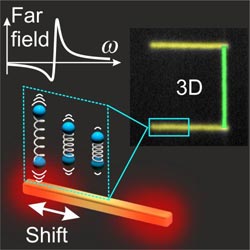Molecular nanoprobe for nanoantenna optical near-fields

Molecules (blue) are positioned with nanometer accuracy next to three-dimensional optical nanoantennas. Vibrations in the molecules are excited. The oscillation strength depends on the near-field distribution (red) and can be measured in the far-field.<br><br>(University of Stuttgart)<br>
Researchers at the University of Stuttgart measured for the first time optical near-field intensities of three-dimensional nanoantennas. The team of Prof. Harald Giessen at the 4th Physics Institute achieved those results with a novel scheme of nanospectroscopy and published their paper in the journal “Nature Communications”.*)
Their method gives new insight into light-matter coupling at the nanoscale and allows precise measurement of enhanced optical near-field intensities generated by optical antennas. This technique can facilitate the engineering of future sensing platforms with extremely high sensitivity.
Molecules exhibit vibrational resonances in the mid-infrared and terahertz regions which is called the molecular fingerprint since it is unique for each substance. With far-field spectroscopy techniques, molecules can be detected and unambiguously identified. Nevertheless, huge quantities of molecules are needed since the excitation of the vibrational resonances is very inefficient. Metallic optical nanoantennas are resonant to incident radiation and generate high near-fields in their direct vicinity. These intensive fields can be used to make small amounts of molecules or even single molecules visible. This plays an important role in early disease diagnostics and in the detection of harmful substances or explosive gas mixtures, such as hydrogen in air.
The Stuttgart group was able to position a few molecules next to gold nanoantennas. Using electron-beam lithography they achieved an accuracy as small as a few nanometers. Due to the high near-field intensities the excitation of the molecular vibrations was orders of magnitude more efficient and was measurable with far-field spectroscopy techniques. By positioning the molecules at different locations with respect to the optical gold nanoantenna the underlying physical process of the vibrational excitation was identified for the first time. In particular, the team of researchers found that the efficiency of the vibrational excitation scales linearly with the near-field intensity generated by the optical antennas.
With this insight the researchers developed a new method to measure quantitatively near-field intensities of optical nanoantennas. The resolution limit of conventional microscopy was overcome since the detection volume using the molecules was much smaller than the wavelength cubed. Compared to state-of-the-art optical near-field microscopy, the method of the Stuttgart group exhibits the unique advantage of measuring near-field distributions of three-dimensional nanoantenna structures. Daniel Dregely was able to incorporate molecules at specific locations during the fabrication process of the antenna structure. He could then detect the vibrational excitation and thus measure the near-field intensity. Such complex nanostructures add another degree of freedom to enhance the interaction of light with single molecules at the nanoscale. The design of future sensing devices will benefit from this new tool of assessing near-field intensities of three-dimensional optical antennas.
*) Reference: D. Dregely, F. Neubrech, H. Duan, R. Vogelgesang, and H. Giessen, “Vibrational near-field mapping of planar and buried three-dimensional plasmonic nanostructures”, Nature Communications (2013). http://www.nature.com/naturecommunications
Contact:
Prof. Harald Giessen, University of Stuttgart, 4th Physics Institute,
Tel. +49 711 68565111, e-mail: giessen (at) physik.uni-stuttgart.de
or
Dipl.-Phys. Daniel Dregely, University of Stuttgart, 4th Physics Institute, Tel. +49 711 68564961, e-mail: d.dregely (at) physik.uni-stuttgart.de
Media Contact
All latest news from the category: Physics and Astronomy
This area deals with the fundamental laws and building blocks of nature and how they interact, the properties and the behavior of matter, and research into space and time and their structures.
innovations-report provides in-depth reports and articles on subjects such as astrophysics, laser technologies, nuclear, quantum, particle and solid-state physics, nanotechnologies, planetary research and findings (Mars, Venus) and developments related to the Hubble Telescope.
Newest articles

Bringing bio-inspired robots to life
Nebraska researcher Eric Markvicka gets NSF CAREER Award to pursue manufacture of novel materials for soft robotics and stretchable electronics. Engineers are increasingly eager to develop robots that mimic the…

Bella moths use poison to attract mates
Scientists are closer to finding out how. Pyrrolizidine alkaloids are as bitter and toxic as they are hard to pronounce. They’re produced by several different types of plants and are…

AI tool creates ‘synthetic’ images of cells
…for enhanced microscopy analysis. Observing individual cells through microscopes can reveal a range of important cell biological phenomena that frequently play a role in human diseases, but the process of…





















